1962 Dutch Grand Prix race report: Hill rings in the new season with debut win
Graham Hill claims his debut win with a dominant victory, the second ever for BRM
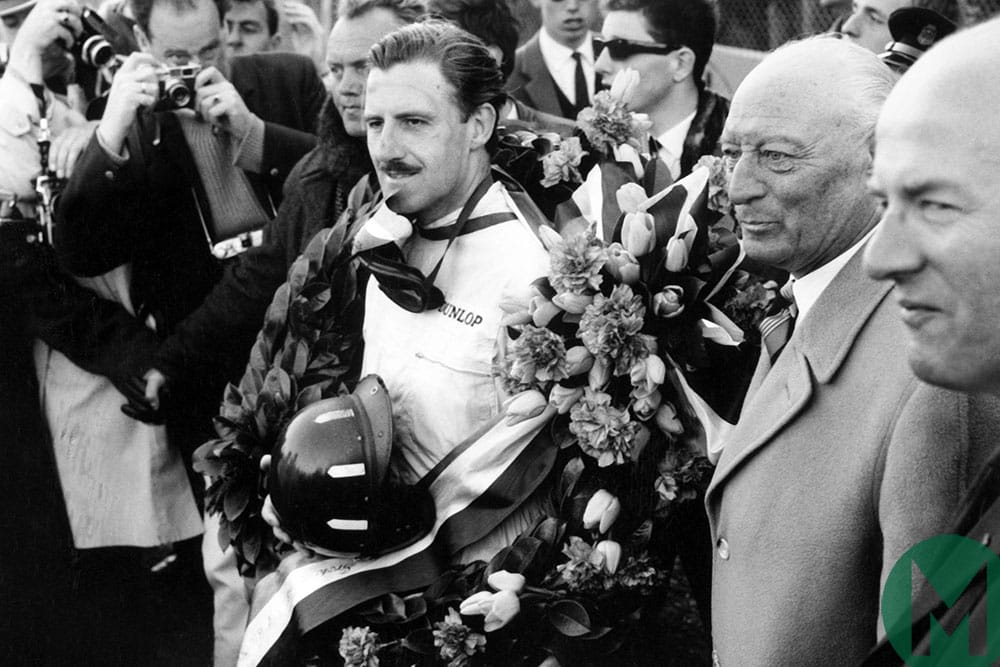
Hill took his debut win at Zandvoort
Motorsport Images
The 1962 Dutch Grand Prix was notable for three outstanding things, it was the first round in the World Championship series, it took the title of Grand Prix of Europe, and it assembled a wealth of technical interest not seen for many a year at a Grand Prix race. The cream of the Grand Prix world were present, as well as some of the sour milk, whose presence only the Dutch Royal Automobile Club could justify.
All the leading teams were entered, but serious private owners with first-class machinery, such as Lewis and Marsh with their V8 BRMs, were turned down in favour of inexperienced or second-rate drivers in obsolete cars. With the field limited to 20 cars this was entirely unjustified, and should be acted upon by the FIA.
Ferrari sent Hill, Baghetti and Rodriguez with 120-degree engined V6 cars, ostensibly as used last year, but with Hill’s car having a modified rear suspension giving a wider track, while the gearbox had a new casing for the 6-speed internals. The 4-valve-per-cylinder engine and centrally placed gearbox have yet to be completed. All three cars had dispensed with the transverse struts on the rear suspension, previously used to prevent any possibility of rear-wheel steering.
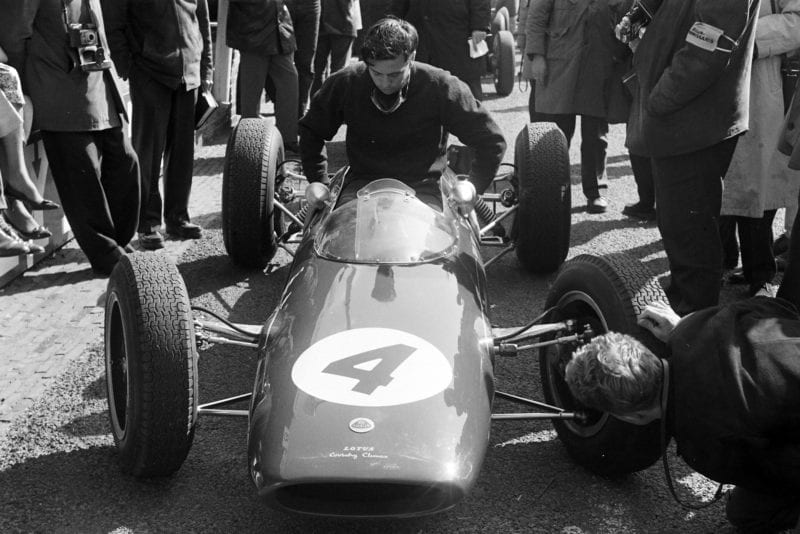
Jim Clark lowers himself into the new Lotus 25
Motorsport Images
The most outstanding feature of the entry was Colin Chapman’s brand-new car, for Clark to drive, this making the Lotus 24 which first appeared at Bruxelles now obsolete, and also making a number of dissatisfied customers. Casting away all thoughts of small-diameter tubes and space-frames, the new Lotus 25 has a chassis formed by two long boxes of riveted construction, made from 16 swg L72 aluminium sheets. These are spaced just wide enough for the driver to sit between, and are joined by a similar box behind the driving seat, the instrument panel, the undertray and a square-tube framework at each end. These boxes carry petrol so that the chassis and petrol tanks are one and the same thing, the boxes being approximately 10 in deep by 6 in wide. The front suspension is bolted to the front and the rear suspension on the back, while the V8 Coventry-Climax engine sits in the cradle behind the driver, readily accessible and not covered by frame tubes or such-like.
“The most outstanding feature of the entry was Colin Chapman’s brand-new car”
The “monocoque” chassis also forms the lower half of the body, the top half, with windscreen being merely a cover over all the mechanism and the driver. Front and rear suspensions are identical with the previous Grand Prix Lotus as is the ZF gearbox with its rubber universal-joint drive shafts. This riveted “monocoque” structure, like an aircraft, makes for greater rigidity with less weight and provides improved engine mounting, accessibility and servicing. The V8 Coventry-Climax engine has an improved carburetter layout with the four double-choke Webers mounted transversely and in a row, providing improved inlet passages and simplification of the throttle linkage. With Clark on this new car the previous works Lotus V8 passed to Trevor Taylor, his first outing in such a potent machine.
The works Coopers were dull by comparison with Lotus, McLaren having a brand-new car with V8 Coventry-Climax engine, also with the new Weber layout, the chassis being an improved version of the 1961 Cooper, with lighter and smaller chassis frame, modified rear wishbones, incorporating an “anti-steer” strut, and new Cooper 6-speed gearbox/differential unit, using rubber-covered pot-type inboard universals. While everyone else points the two tail pipes of the Climax V8 up in the air, Cooper points his down at the ground.
The second Cooper was a 1961 works 4-cylinder for Tony Maggs to drive. Brabham was entered as a private entry with his new V8 Climax-engined Lotus 24, being identical to what used to be the latest works cars, until Chapman produced his “monocoque” car seemingly from-out-of-a-hat. Ireland had UDT-Laystall’s number one car, a new Lotus 24 with V8 Climax, as tried out in the Silverstone race by Masten Gregory, this like Brabham’s also having the new carburetter layout. As a stop-gap, until their V8 BRM-engined car is completed, Gregory had one of UDT’s old Lotus 18 chassis with 4-cylinder Climax engine.
Rivalling the Lotus 25 for the lead in technical innovations were the two factory Porsche cars for Bonnier and Gurney. These were the long-awaited flat 8-cylinder air-cooled cars, and while the engine was unchanged from those seen on test last year, they were mounted in entirely new chassis frames. The narrowness of the chassis is dictated by the width of the horizontally opposed 8-cylinder engine, and is a tubular space-frame, but the suspension brings a new note in that it is by torsion bars. At the front a narrow top wishbone pivots on the chassis and twists a longitudinal torsion bar which is mounted alongside the top chassis tube. The wishbone extends inwards to form a Lotus or Maserati-type rocker arm and the inner end compresses a Koni shock-absorber and is also coupled to a tiny anti-roll bar in pure Lotus fashion. The bottom wishbone is an obtuse triangle not unlike a Lola, while steering is by rack and pinion.
At the rear the rather complex double-wishbone layout used on the 4-cylinder cars has been replaced by a very simple double-wishbone layout, with the top one turning a longitudinal torsion bar. All four torsion bars have screw adjustments at their ends, to control the height of the suspension. Porsche alloy bolt-on wheels are retained, and Porsche disc brakes are fitted. The main fuel tank is formed in the shape of the driving seat, and is supplemented by another tank in the nose of the car, alongside the oil tank, while an oil radiator is the most forward mounted unit.
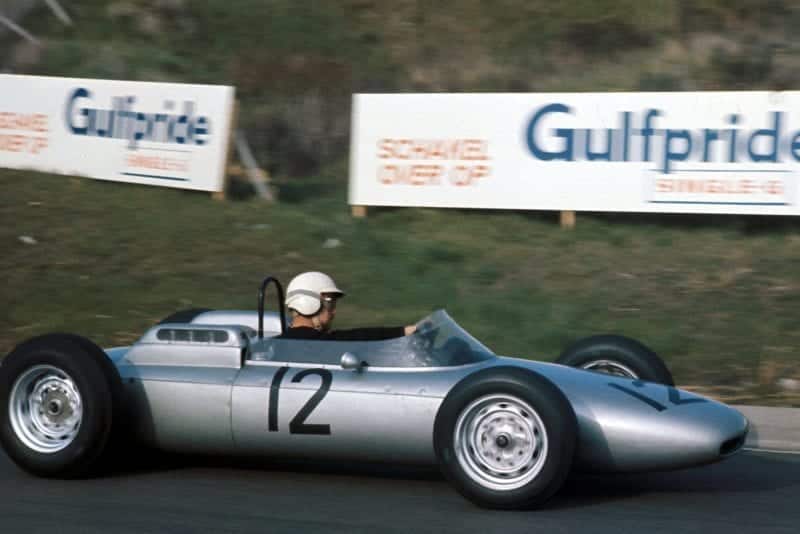
Dan Gurney put his Porsche in 8th place on the starting grid
Motorsport Images
The 8-cylinder engine, with its four overhead camshafts is mounted directly behind the driver and is coupled to a 6-speed gearbox that extends out the back of the car. The engine has separate finned cylinder barrels enshrouded in a fibre-glass ducting and a fibre-glass horizontally mounted fan above the engine blows air downwards. From the near-side inlet camshaft a belt drives a small Bosch dynamo mounted within the air-cooling duct, while Bosch coils look after the sparks for the sixteen plugs.
Four large-diameter exhaust pipes stick out the back of the car and little attempt has been made to design a body, the aluminium fairings being little more than covers for the mechanism. In addition to the two factory Porsches there were two 4-cylinder cars driven by Dutchmen de Beaufort, having borrowed back his old Porsche from Seidel, and Ben Pon having been loaned a factory 4-cylinder Porsche with Bosch fuel injection and horizontal cooling fan. These two were entered by de Beaufort’s Ecurie Maarsbergen, as was Seidel who having no Porsche “borrowed” the factory Emeryson-Climax.
Back to the more serious side of the entry, BRM had two cars, the 1962 V8 which Graham Hill had been so successful with at Goodwood and Silverstone and a 1961 chassis modified to take the V8 engine, for Ginther. This latter car was built for Ashmore, but after Ginther wrote-off his 1962 at Silverstone the factory had to borrow the customer’s car. Both cars were on Lucas fuel-injection and were running as in previous races, being well satisfied with the results so far obtained.
Finally there was the Bowmaker-Yeoman team of Surtees and Salvadori with Lolas and both had Coventry-Climax V8 engines, with Colotti gearboxes, Surtees having the car he has already raced, and Salvadori having a Lola chassis previously used with a 4-cylinder engine, identical apart from small modifications to the rear wishbones. The total of 20 cars should have been completed by Trintignant with a Team Walker Lotus but their new Lotus 24 with V8 Climax engine was not ready, the Lotus 21 was still not back from New Zealand and the 4-cylinder they borrowed for Pau was wanted by UDT for spares.
Having refused Jack Lewis with his V8 BRM the Dutch organisers suddenly panicked on Thursday evening and phoned him saying he could enter after all, this being when they discovered Trintignant could not come. Not unnaturally the BRM was not ready so Lewis came in a great rush with his 1961 Cooper-Climax 4-cylinder, and could not make it in time for the first practice day.
Qualifying
BRM had already been to Zandvoort two weeks before-hand to try their cars and had put in some excellent unofficial lap times, so that when practice began on Friday morning they were already ahead of everyone else as regards various adjustments on the cars. Although the day was sunny there was the inevitable strong, cold wind blowing down the finishing straight, which was hampering drivers on the back part of the circuit.
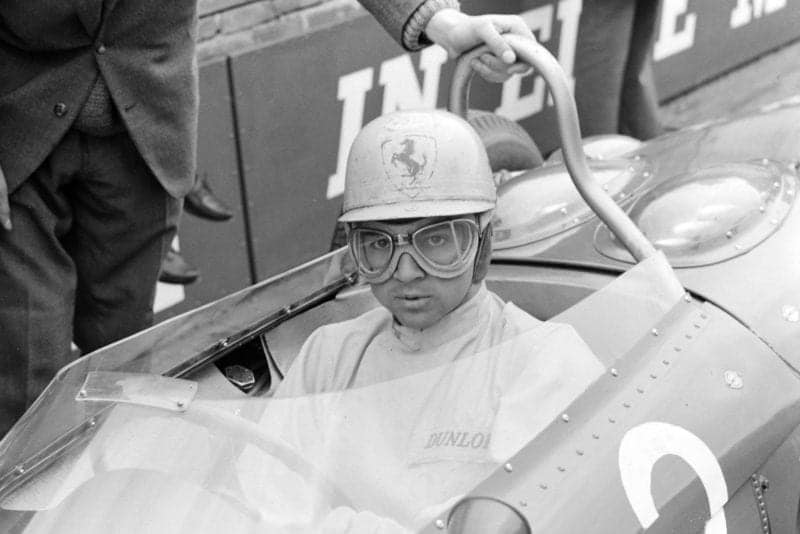
Ricardo Rodriguez was making his second Ferrari appearance
Motorsport Images
Ferrari were not in a happy state for two of their drivers had never seen the Zandvoort circuit before and the cars being more or less as last year they had little hope of improving on their 1961 times of just under 1min 36.0sec. However, Graham Hill was in fine form and was soon well down below last year’s fastest times and was not far off the ultimate lap record of 1min 33.8sec set up by Moss in 1960 with a 2.5-litre Lotus-Climax. Ginther was following him steadily, but not as fast, still rather conscious of having recently written-off one of the cars.
“Ferrari were not in a happy state for two of their drivers had never seen the Zandvoort circuit before”
Apart from Brabham, Seidel and Lewis, everyone was out practising and the pit area was so full of interesting machinery coming and going that it was difficult to know which way to turn, while the air was full of the most wonderful noises. If it wasn’t a Climax V8 or Ferrari V6 going by on full song, it was the deep boom of a V8 BRM or the entirely new noise of the flat-8 Porsche. Cooper was doing final adjustments to the Weber carburetters on his new car, and also adjusting the selectors of the new 6-speed gearbox; Ferrari were altering rear-wheel camber angles, Porsche were looking worried because their drivers were not satisfied with their exciting new cars, Parnell was sorting-out Surtees’ V8 Lola-Climax, it being Lola’s first visit to Zandvoort, and Salvadori was practising with a Cooper-Climax as his V8 Lola was still being finished.
The new Lotus was riding the humps beautifully but was naturally requiring a few minor adjustments and Clark tried his old V8 Lotus to make a comparison. There was so much activity and interest in the pits that two hours passed in a flash and the first practice session was over with Graham Hill being a full two seconds faster than anyone else, with a time of 1min 33.3sec.
At 3:30pm it all began again and this time Brabham joined in with his vivid green Lotus-Climax V8 and Seidel with the dark green Emeryson. All the excitement and activity continued unabated and the sound of really exciting racing engines rent the air all afternoon. This was true Grand Prix practice, provided by the best and latest in design, with four opposing views on engines, Ferrari V6, BRM V8, Climax V8 and Porsche flat-8; and six opposing views on chassis design, Ferrari, BRM, Lotus, Cooper, Lola, Porsche and Emeryson.
Not everyone was happy, for Trevor Taylor did only one lap and his V8 Climax engine had valve-gear trouble and chewed-up its camshaft drive, and Gregory had barely started before a piston broke. The new Porsche engines seemed fine but the drivers were far from content with the handling, but they seemed unable to allow for the fact that it was a brand-new and un-raced chassis and suspension, still in need of development. Gurney finally determined to have a proper go and he wrestled the car round in a rather wild and untidy 1min 34.7sec, which was 2 sec faster than he did last year with the old 4-cylinder car.
Bonnier did not approach this performance. Of the V8 Climax engines Coopers had got theirs really singing, with nice clean carburation out of the corners and McLaren was getting in the running, but Jimmy Clark was much faster in the new Lotus, in spite of mediocre carburation. He got down to 1min 33.6sec, but Graham Hill had already overshadowed this with 1min 32.6sec and at that had put the car away while it was still in one piece.
In the Ferrari team Phil Hill was managing to retain his leadership, being more than 1sec faster than his young team-mates, and Innes Ireland was keeping UDT-Laystall very happy by lapping in 1min 34.1sec in their V8 Lotus-Climax. In the Lola pits there was a feeling that the cars were not right and they were fiddling about making improvements, but Surtees’ best time was 1min 35.0sec, which equalled Ferrari’s best time, and this was their first real motor-race with the V8 Lola Grand Prix cars.
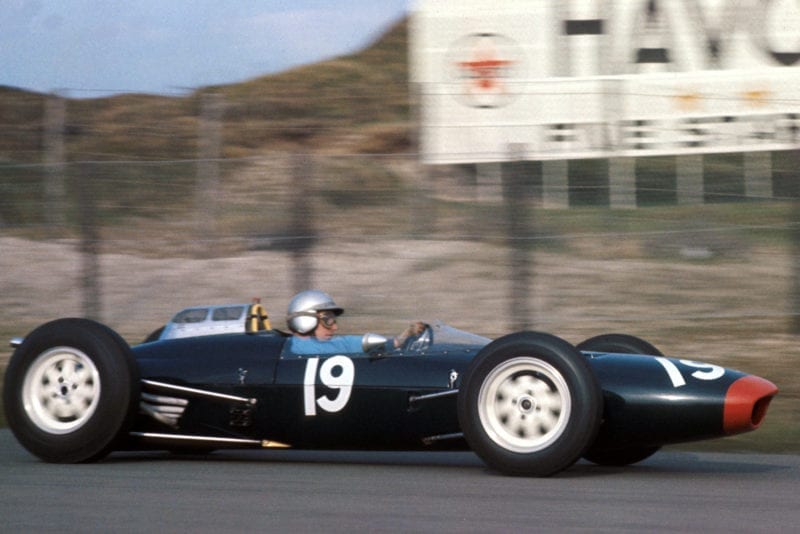
Surtees impressed in the Lola Mk4, matching Ferrari’s Phil Hill
Motorsport Images
Practice finished at 5:30 pm and not for a long time has there been such an interesting day of Grand Prix practice, while speeds and performances were going ahead with leaps and bounds. Seven drivers had improved on the lap record of 1 min 35.5 sec, set up last year by Jimmy Clark in the then new Lotus 21, which is now obsolete.
The final session of practice was on Saturday afternoon for a further two hours but this time the sun had gone and rain was impending, while the inevitable wind was even stronger and colder. Some of the teams had done sufficient practice and were content with a few laps, while others were either in trouble or trying to effect improvements.
Clark started off in the new Lotus but had a nasty noise appear in the gearbox, and it was quickly removed and investigated, while Trevor Taylor practised with a 4-cylinder Lotus-Climax 24 that Team Lotus had with them as a spare. Neither Porsche nor Ferrari were showing much improvement, but Brabham was getting down to some very serious motoring and Lola were beginning to go, Surtees getting sufficiently rapid to worry Graham Hill.
However, the number one BRM was being worked on in its van and by the time it was ready to run Surtees had made a new FTD with 1min 32.5sec, which rather disproved his theory that the handling of the Lola was not very good. McLaren was putting in some really fast laps when a shaft broke in the gearbox and he came in riding on the tail of Maggs’ car. At the end of the afternoon Graham Hill went out in the V8 BRM and though he did a series of laps in the 1min 33.0sec bracket, he could not approach the time put up by Suttees in the Lola-Climax. Just as practice finished the rain came down and everyone went back to their garages to prepare for the race proper.
With five different types of car in the first two rows of the start the 1962 Grand Prix of Europe had the makings of quite a race. On the front row were: Lola-Climax V8, BRM V8, Lotus-Climax 25 V8, followed by Lotus-Climax 24 V8 and Cooper-Climax V8 – could anyone wish for anything more exciting – and just behind were Porsche and Ferrari. Colin Chapman had flown Taylor’s damaged V8 engine back to Coventry and rebuilt another one, and UDT-Laystall had also flown to England to collect a spare engine for Masten Gregory’s car.
Race
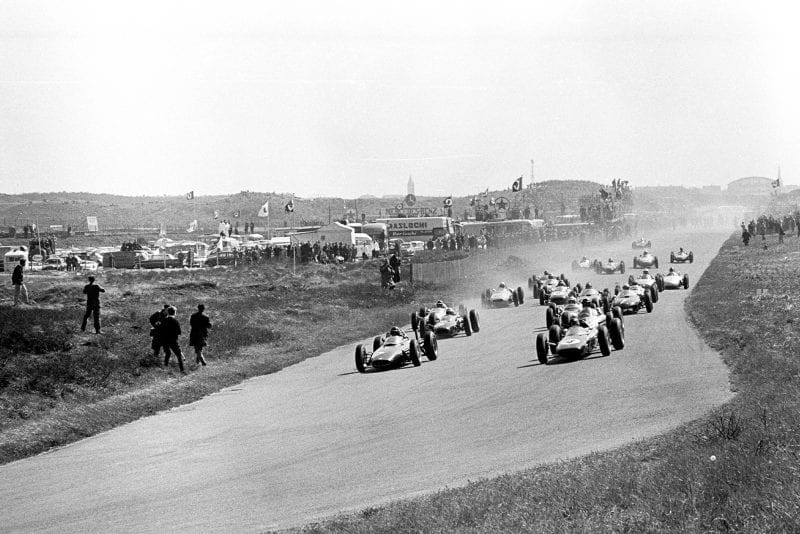
Clark and Maggs lead the field at the start
Motorsport Images
By Sunday lunch-time everyone was assembled once more, though Taylor’s engine was smoking a bit and the oil pressure was not as high as it should have been. As the cars were driven round to the start Graham Hill’s BRM cracked an exhaust pipe, but there was nothing to be done, and by 3:15pm all twenty cars were assembled on the starting grid.
Five minutes later than scheduled everyone was ready, McLaren was creeping slightly from the second row and in a glorious roar from all the multi-cylinder engines the whole field got away to a perfect start. Although Surtees was in pole position, Clark was best placed to cut across into the first corner, and this he did, leading Graham Hill and Gurney who had followed the “monocoque” Lotus closely. They kept that order on the opening lap and were followed by Surtees, Phil Hill, Ireland, McLaren, Rodriguez, Taylor, Brabham and the rest, with Ginther way at the back, his BRM V8 engine not running properly.
“Rodriguez spun in the middle of the howling mob and Brabham struck one of the Ferrari’s wheels and crumpled the front of his Lotus pretty severely”
On lap 2 the first four remained the same but Ireland now led McLaren and Phil Hill, while Taylor had passed Rodriguez and Ginther had dropped even further back. On lap 3 Clark had already got 2.5sec lead over Hill’s BRM, and Gurney was firmly in third position but then came a howling mob led by Surtees, there being seven cars vying for fourth place. At the back of the field the Dutchman Pon spun off into the sand and retired and on the next lap Rodriguez spun in the middle of the howling mob and Brabham struck one of the Ferrari’s wheels and crumpled the front of his Lotus pretty severely. Brabham limped round to the pits to retire and Rodriguez struggled to get his car out of the sand, taking two laps to do so.
While the first three places remained unchanged the battle for fourth place continued, with McLaren now taking command and Taylor challenging Surtees. Once away from the crowd McLaren established himself in fourth place, but Taylor was challenging Ireland, only to spin on lap 9 and drop behind Phil Hill, while on the same lap Surtees had the top left front wishbone break on his Lola and he slid off into the safety fence at high speed, escaping unhurt.
At 10 laps the order was Clark, Graham Hill, Gurney, McLaren, Ireland, Phil Hill, Taylor, Baghetti, Gregory, Maggs, Bonnier, and Lewis, the rest trailing along. Ginther’s engine was still not running properly, all was not well with Salvadori’s engine, and Seidel was in and out of the pits with the Emeryson. The position was far from stable for Clark was having trouble selecting gears due to his clutch not working properly and was a bare second in front of the BRM and McLaren was closing on Gurney, but for a brief moment there was the interesting situation of four different makes in the first four places.
Lotus, BRM, Porsche, and Cooper, all with 8-cylinder engines. As they went round behind the pits Gurney slowed to a stop and then went on slowly, his gear-lever having come out of its mounting, and at the end of lap 11 Graham Hill was right on Clark’s tail and as the Lotus left the 180-degree Tarzan curve it slowed and Hill went by. Clark’s clutch was refusing to grip and, like Gurney he limped round and stopped at the pits.
When Surtees walked back to the pits and reported what had happened Parnell called Salvadori in and withdrew the car, rather than risk another breakage, and meanwhile Lotus mechanics were under the back of Clark’s car sorting out the clutch adjustment and Porsche mechanics were in Gurney’s cockpit putting the gear-lever back into its socket. Graham Hill was now unchallenged and was drawing away steadily from McLaren, the cracked exhaust pipe on the BRM having little effect on the performance.
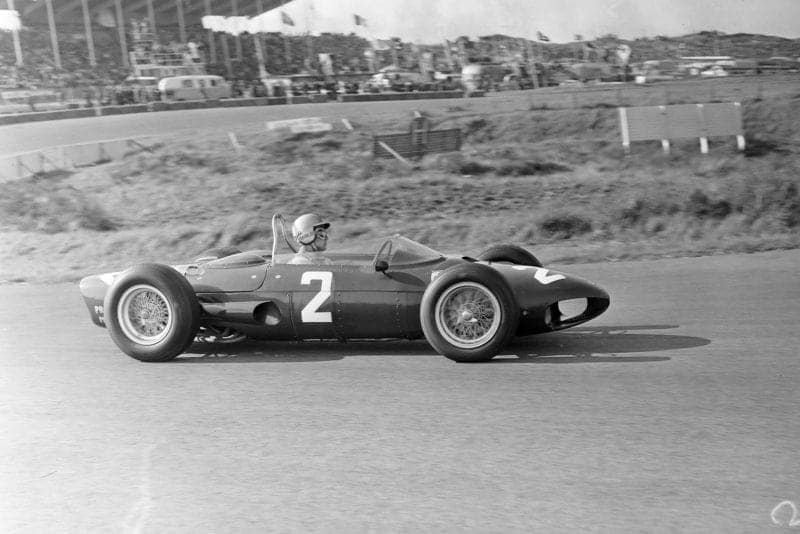
Baghetti brought his Ferrari home in 4th
Motorsport Images
Things now settled down and Rodriguez was running in close company with Baghetti, but two laps behind, and Ginther’s BRM was beginning to “clear its throat” and go properly. While the leader was on lap 17 Gurney rejoined the race, the Porsche sounding as healthy as ever, and as Graham Hill started lap 20 Jimmy Clark rejoined the race once more.
By this time there were only seven cars on the same lap as the leader, McLaren being 12 sec behind, Phil Hill 23sec he having passed Ireland, who was 31 sec behind, and then came Taylor at 42sec, followed by Baghetti, Gregory and Maggs, the rest being lapped. This situation was too much for Bonnier and he stopped at the pits to complain about the rear-end of the car, but nothing could be found wrong and he was sent on his way again, but now two laps down.
Once more the situation changed when McLaren came to rest out on the circuit with a gearbox shaft broken, as in practice, and Phil Hill now found himself second some 25 sec behind Graham Hill, and things settled down. By lap 30 the BRM had 31sec lead and was lapping steadily at 1min 38.0sec, but Trevor Taylor was closing rapidly on Ireland and down at the end of the field Ginther was beginning to pick-up places. With comparative ease Taylor nipped by Ireland and this seemed to give him confidence for he set out to catch Phil Hill, leaving Ireland behind quickly.
Gregory was lapped by Graham Hill and took the opportunity to use the BRM as a pace-maker and by keeping behind for a number of laps he closed up on Baghetti quite a lot. Bonnier was going round sadly until he realised he was only just keeping up with de Beaufort, whereupon he woke up and began trying.
At 40 laps, which was half-distance, Graham Hill was lapping very comfortably, if somewhat lonely at 1min 39.0sec, and was 34sec ahead of his namesake in the red Ferrari, but Taylor had reduced the gap between his Lotus and the Ferrari from 12sec to 7sec and was still gaining yard by yard. Only Ireland and Baghetti were on the same lap as the first three by this time, and it obviously would not be long before the Italian was lapped.
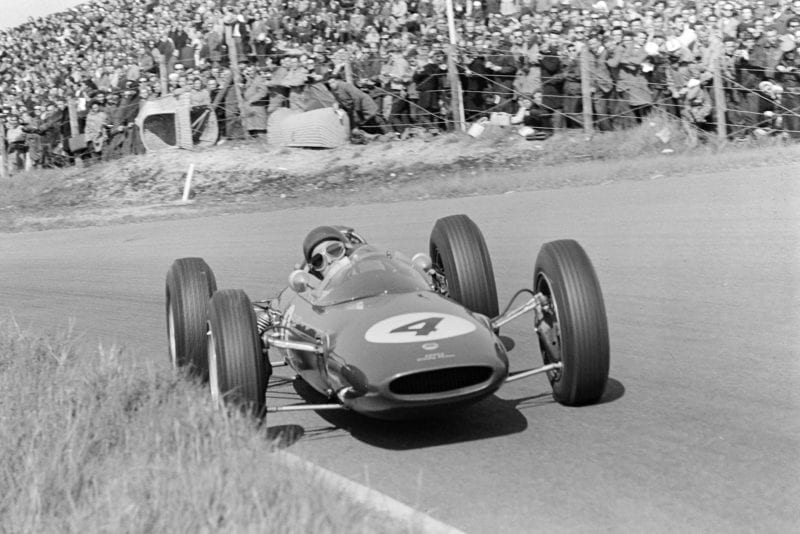
Clark led until mechanical failure on lap 11
Motorsport Images
On lap 37 Lewis had suddenly stopped, his engine having cut-out and refusing to start again; he walked back to the pits then returned to the car, pressed the starter and away it went, having cooled down so he rejoined the race, in front of Clark who was now running last, apart that is from Seidel who was barely running. Gurney’s efforts now came to an end for a bracket broke in the gear-change line between the gear-lever and the gearbox, and by 50 laps Baghetti was lapped by Graham Hill who was driving a faultless race, his car sounding perfect.
On lap 55 Gregory drew onto the grass and out of the race with a broken gearbox, but all eyes were now on Taylor for he had closed the gap to 5sec, and while the diference per lap appeared to be the same, over five laps it was measurable and by lap 60 it was down to 3sec; in addition Ginther was catching Maggs, for sixth place.
As they started lap 61 Taylor was right behind the Ferrari and then Ireland passed in fourth place, stood on the brakes for the hairpin at the end of the pits straight, and the car did a quick flip off the track, through the safety fence, to land on its wheels on the infield. A rather dazed and bewildered Ireland staggered away from the car miraculously unhurt. This little excitement rather overshadowed the fact that Taylor went by Phil Hill into second place with no trouble at all. This put him 27sec behind the leading BRM and Graham Hill was content to keep it at that, his pit staff keeping him fully informed of the situation.
“Ireland stood on the brakes for the hairpin at the end of the pits straight, and the car did a quick flip off the track, through the safety fence, to land on its wheels on the infield”
By lap 70, with only 10 to go, Ginther was in sight of Maggs and shaping up to pass him, and at the same time Taylor was closing up to lap them both. On lap 72 the Lotus tried to get by the BRM as they braked for the Tarzan curve, then tried to out-accelerate it but still failed, and as they went into the hairpin behind the pits Taylor tried to get by on the inside, opened up a bit too soon and very nearly lost the lot. Ginther was not going to lift off and move over as he was busy trying to get by Maggs, so it was up to Taylor to find his own way past.
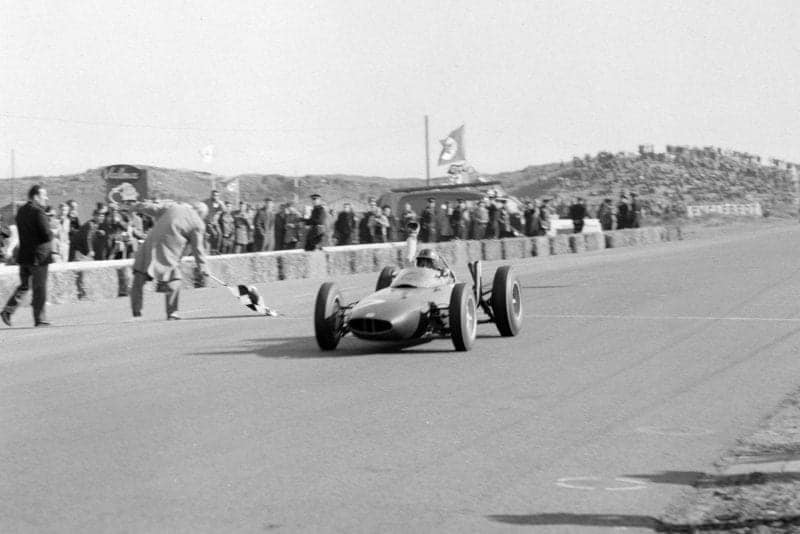
Hill claims victory
Motorsport Images
On the next sharp right-hander the Lotus was almost touching the BRM when Ginther’s engine fluffed momentarily, but it was enough for the Lotus nose to hit the BRM tail and Ginther spun off into the sand, leaving Taylor to go on his way with a slightly crumpled nose cowling. That completed the excitement for the day, and there certainly had been plenty, but It was nothing compared to that of the BRM team when Graham Hill swept home a most worthy winner of the GP of Europe, followed by Trevor Taylor who had literally shone in the closing stages of the race, with Phil Hill in third place, his Ferrari losing oil during the last ten laps of the race.
Zandvoort Zooms
- The anti-Surtees element will no doubt add this one to his list of accidents, but a broken wishbone would make anyone crash.
- We are not going to suggest anything, in case somebody wants to start a libel action, but it must be reported that since Peter Berthon left the BRM racing team they have won Goodwood, Silverstone, and now a World Championship event.
- One hopes the Grand Prix Drivers’ Association will do something about the way entries are “fiddled” in Championship events. Surely Grade 1 drivers should be accepted first, or doesn’t Jack Lewis count as a Grand Prix driver ?
- Zandvoort is certainly zandy and also zafe; four cars crashed and no one got hurt, which is nice to record.
